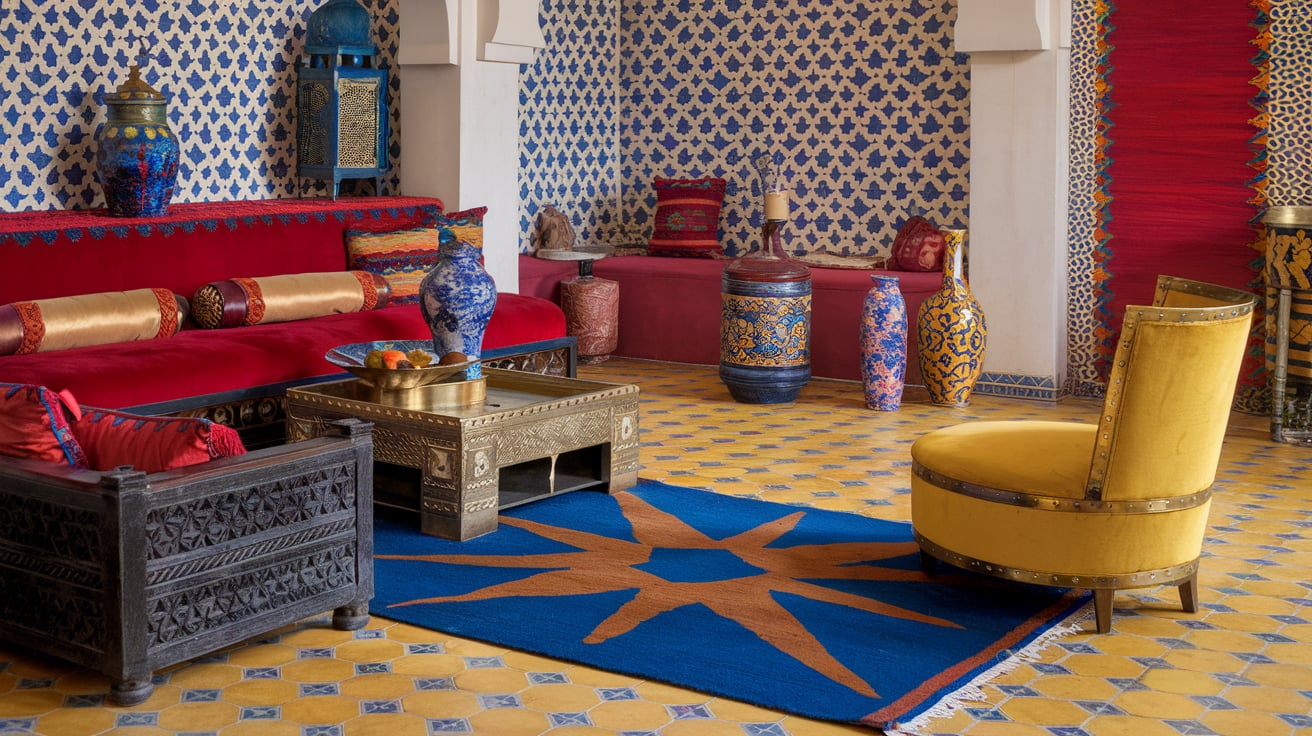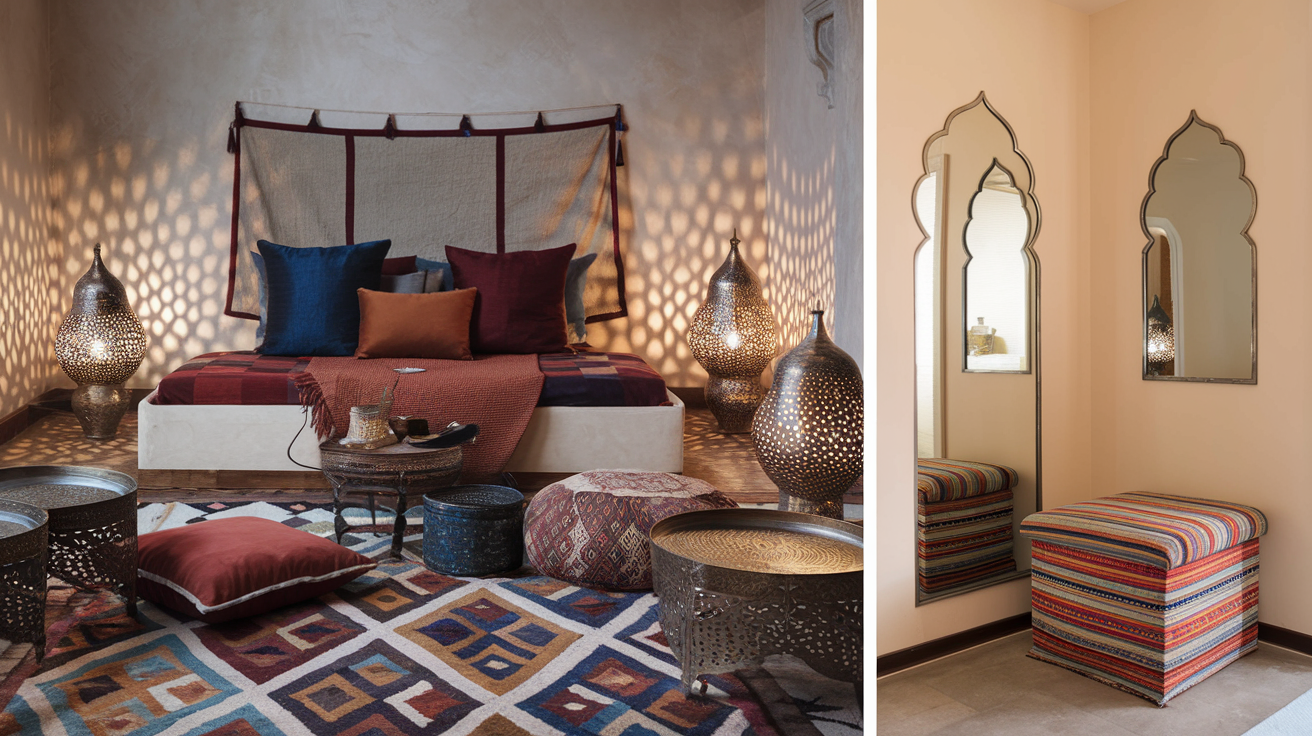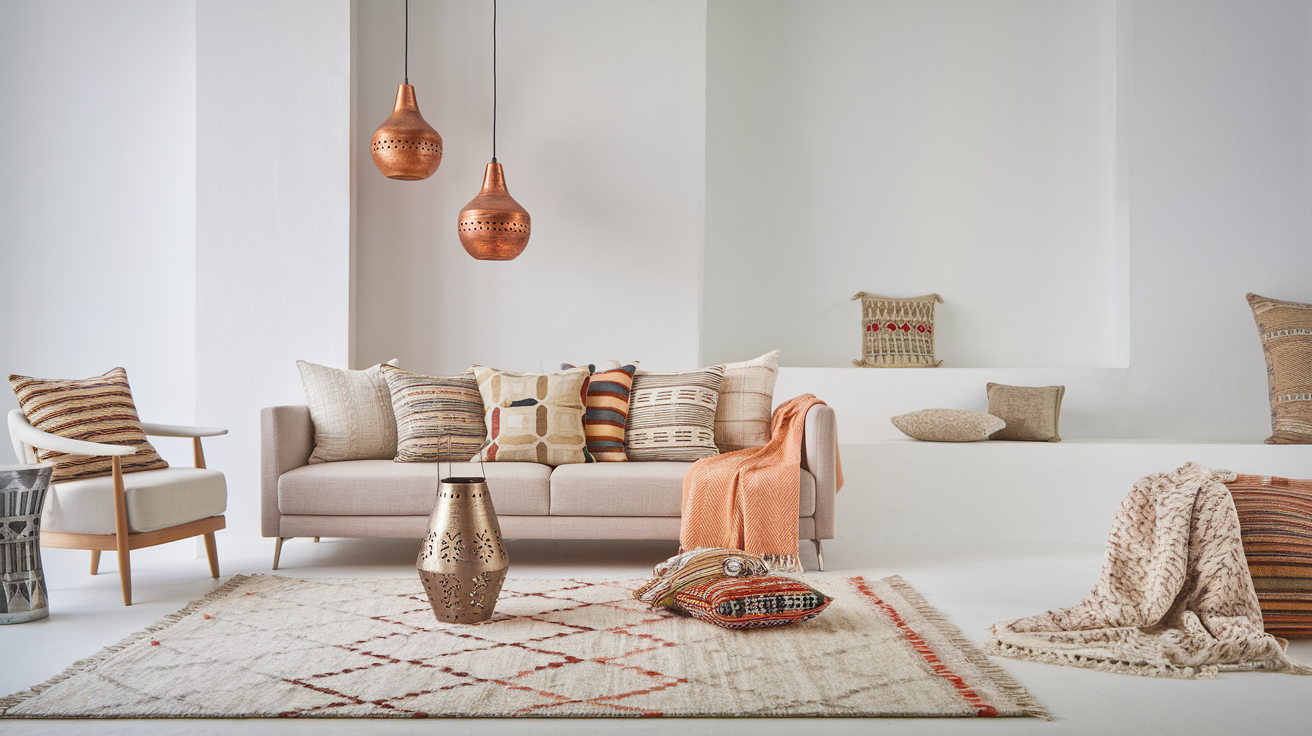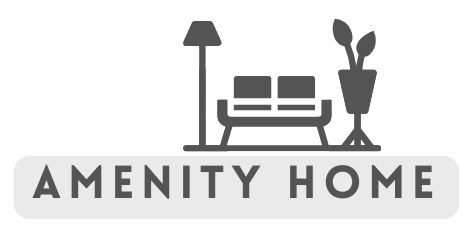Moroccan design has deep roots in North African culture and history. It mixes Arab, Berber, and Mediterranean styles, creating spaces known for bold colors, detailed patterns, and varied textures.
This design style shows Morocco’s unique position as a crossroads of many cultures over centuries. You can see this in the mix of geometric shapes and flowing lines in rugs, tiles, and architectural details.
People worldwide value Moroccan design for its warmth, comfort, and careful attention to detail, making spaces feel both lived-in and special.
In this blog, we’ll cover what makes Moroccan interior design special, how you can use it in your home, design ideas, and much more.
Let’s get straight to it!
Key Elements of Moroccan Interior Design

Moroccan design blends comfort with beauty in a style that feels both cozy and eye-catching. The mix of colors, patterns, materials, and furniture creates spaces that feel warm and welcoming.
Let’s look at what makes this style special.
Colors
Moroccan design mixes bright colors with earth tones.
You’ll see reds, blues, oranges, and yellows that add life to rooms. Browns and tans create a nice balance with these brighter shades. Gold touches often show up on important pieces in a room.
These add a touch of luxury without going overboard.
Patterns
Geometric shapes form the core of most Moroccan patterns.
You’ll notice stars, hexagons, and complex repeating designs throughout these spaces. Curved arabesque motifs and colorful mosaic tiles (called zellige) create striking visual impact on walls and floors.
These patterns tell stories and add depth to each room.
Materials
The key materials include colorful tiles, soft velvet fabrics, rich mahogany wood, shiny brass objects, and detailed wrought iron work. When you touch these materials, you feel the mix of smooth and rough textures.
This blend creates rooms that appeal to both your eyes and hands.
Furniture
Moroccan rooms typically have low, plush seating that makes you want to sit down and chat. These comfortable spots are perfect for family time and hosting friends.
Wooden furniture often shows off detailed hand carving, with complex designs that skilled craftspeople spend many hours creating. Each piece feels special and one-of-a-kind.
How to Incorporate Moroccan Style in Your Home

Living Room
Start with a colorful Moroccan rug as your room’s centerpiece. These rugs typically feature geometric patterns in rich colors that instantly add warmth.
Add floor cushions around a low table to create a casual seating area perfect for gathering with friends.
For lighting, try metal lamps with tiny holes that cast patterned shadows across your walls. A few metal trays or tables with detailed work can complete the look without going overboard.
Bedroom
Transform your bedroom into a peaceful space using Moroccan-inspired textiles.
Layer your bed with covers and pillows in complementary colors like deep blue, burnt orange, or soft red. A fabric headboard or wall hanging can add texture without permanent changes.
Paint an accent wall in a warm color or add a simple stenciled pattern for more impact without overwhelming the space.
Small Spaces
In smaller rooms, focus on just one or two Moroccan elements rather than filling the space.
A single statement piece like a small patterned rug or a metal lamp can add style without crowding the room. Use mirrors with Moroccan-style frames to make spaces feel larger while adding character.
Choose multipurpose items like storage ottomans covered in colorful fabric that serve as seating and storage.
Moroccan Design for Different Rooms

Kitchen
Create a striking kitchen with colorful tile backsplashes in traditional Moroccan patterns. These tiles work well behind stoves or sinks, adding style and practical wall protection.
For cabinets, consider painted wood in blue or green tones or natural wood with simple cutout designs. Open shelving lets you display colorful dishes and pottery that enhance the Moroccan feel.
Metal pendant lights hung over an island or eating area can tie the whole look together.
Bathroom
Transform your bathroom into one unlike any other using Moroccan design elements. Install patterned floor tiles in blues and whites for a clean yet interesting base.
Consider a tiled accent wall in the shower or behind the sink. Add a metal mirror with an interesting shape or pattern for a focal point.
Finish with practical items that also add style – think woven baskets for storage, glass containers for cotton balls, and plush towels in colors that match your tiles.
Outdoor Spaces
Turn your patio or garden area into a relaxing outdoor space with Moroccan touches.
Start with comfortable seating using weather-resistant fabrics in bright colors. Add a metal side table with cutout patterns that cast interesting shadows. Lanterns placed on tables or hung from trees create the prettiest lighting in the evening.
A water feature, even a small one, adds the pleasant sound common in traditional Moroccan courtyards. Potted plants like citrus trees or herbs complete the Mediterranean feeling.
Combining Moroccan Design with Other Styles

Moroccan design brings rich colors, patterns, and textures that work well with other design styles. Here’s how to blend Moroccan touches with different interior approaches for a unique home feel.
Mixing with Modern Style
Modern design focuses on clean lines and open spaces. To add Moroccan elements:
- Place a few patterned cushions on a simple modern sofa
- Add a metal lantern with geometric cut-outs on a plain coffee table
- Use a single colorful Moroccan rug as the focal point in a neutral room
- Install simple pendant lights with subtle Moroccan patterns
The key is balance—let the Moroccan items stand out against the simpler modern background.
Pairing with Minimalist Design
Minimalist spaces value “less is more.” Try these combinations:
- Choose one statement Moroccan piece, like a handcrafted side table
- Add small touches of warm metals (copper, brass) to bring in Moroccan warmth
- Select Moroccan items in neutral colors that match your minimalist palette
- Use textured Moroccan throws or pillows for subtle depth
This approach adds character without overwhelming the calm, minimalist feel.
Blending with Scandinavian Style
Scandinavian design values light, function, and coziness. Combine with Moroccan elements by:
- Using Moroccan textiles in light, muted colors
- Adding a simple patterned pouf for extra seating
- Incorporating small metalwork pieces that catch the light
- Choosing Moroccan-inspired wall hangings in simple frames
The natural materials common in both styles create a smooth connection between them.
Benefits of Mixed Design Approaches
When you mix different cultural design elements, you create spaces that truly feel like yours. Your home tells your own story through its unique look.
You’ll enjoy rooms full of interesting textures and visual appeal. This approach gives you flexibility to update your space as you find new items you love. These mixed designs show an appreciation for global styles.
The best part? Your home won’t look like you bought everything from one store. Instead, it feels like a collection of special finds gathered over time.
Conclusion
Moroccan design stays popular because it mixes beauty with meaning. The patterns, colors, and textures bring warmth to any home.
To create your own Moroccan-inspired space, start small with a few key pieces that speak to you. Pay attention to quality craftsmanship and authentic materials. Mix old and new items for a lived-in feel.
Most importantly, create a space that makes you feel good when you’re in it.
The best homes tell stories about the people who live there, using bits of different cultures to create something truly personal.














